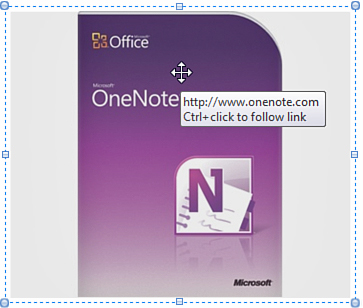Creating a Link from a Picture
Quite similar to making text clickable, you can also
format a picture, a scanned image, or a screen clipping to contain a
link that points to a website.
To create a link from a picture, follow these steps:
1. | In your notes, click an inserted picture from which you want to create a link.
|
2. | On the ribbon, click the Insert tab.
|
3. | In the Links group, click Link.
|
4. | In the Link dialog box, type the full website URL (for example, http://www.onenote.com) into the Address box and then click OK.
|
Although
linked text will tip you off about its clickability by changing to a
blue and underlined type style, linked pictures do not show any obvious
sign of containing a link.
However, when you move the mouse pointer over a
picture that contains a link, a ToolTip appears, showing you the
destination of the link (see Figure 4).

Just below the web address in the ToolTip, you’ll
also see the instruction to hold the Ctrl button if you want to click
and follow the link from the picture. This intentional link activation
isn’t meant to make life more difficult for you. It makes clicking a
link from a picture a more deliberate action and it preserves the
ability to easily select, format, and work with pictures that contain a
link. Without this Ctrl key click confirmation, you could never again
click to select a picture to format, move, or delete it without
constantly opening its link in a web browser.
Modifying a Link in Your Notes
If you want to update the web address that a link in your notes points to, you can easily edit it.
To modify a link in your notes, follow these steps:
1. | On the page, right-click the text or the picture that contains the link you want to modify.
|
2. | On the shortcut menu that appears, click Edit Link. |
3. | In
the Link dialog box that opens, the URL of the link is already selected
for you in the Address box. Type over this address with the new or
corrected link and then click OK.
|
For manually created links from a word or phrase of
text that describes the link, or for links from pictures, you needn’t
do anything else to modify a link. However, if you used the previous
steps to modify a text link that OneNote automatically created from a
web address or URL that you typed, modifying the link in the dialog box
will not change the clickable text you see in your notes.
For example, if the link you edited originally appeared in your notes as www.microsoft.com in a blue, underlined style, and you then change the Address field in the Link dialog box to www.adobe.com, the link will now point to the Adobe website but the displayed text will continue to appear as www.microsoft.com,
as before. To avoid this, make sure that you also change the Text to
display field in the Link dialog box right above the Address field
whenever you’re changing the existing URL of a link.
|
As a general rule, you should always manually test
every link that you create, especially if you eventually plan to
electronically share any part of your notes with other people.
|
Removing a Link from Your Notes
If you want to delete a link from notes text or from a picture in your notes, follow these steps:
1. | Right-click the text or the picture that contains the link that you want to delete.
|
2. | On the shortcut menu that appears, click Remove Link.
|
|
If you accidentally remove a link that you wanted to
keep, remember the Undo command on the Quick Access Toolbar (or press
Ctrl+Z).
|
This covers the basics of creating and modifying
links in OneNote 2010. Rest assured that OneNote has a few more tricks
up its sleeve when it comes to intelligent
linking. If you looked closely at the Link dialog box, some of that
functionality was already foreshadowed. However, those advanced
features fall more under the subject of notebook organization.